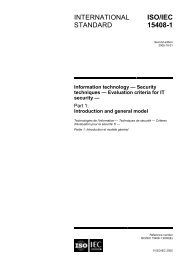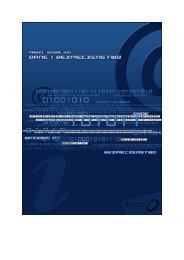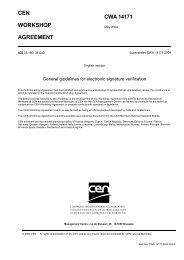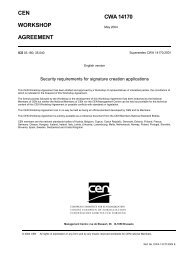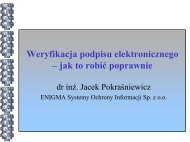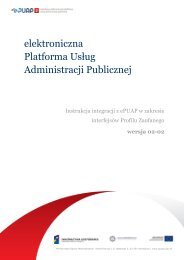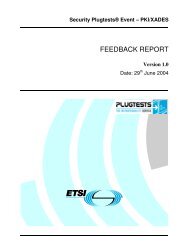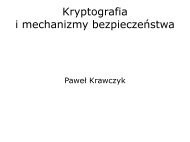When electronic signature becomes a information services ... - IPSec
When electronic signature becomes a information services ... - IPSec
When electronic signature becomes a information services ... - IPSec
Create successful ePaper yourself
Turn your PDF publications into a flip-book with our unique Google optimized e-Paper software.
not installed automatically when the user inserts the smart card into the reader; which means<br />
that it will not work unless the user installs the driver software provided by the vendor. The<br />
intention may not be to compel the customer to use their particular technology, but it enables<br />
the personalisation of a large number of smart cards. This problem is exacerbated, because<br />
some vendors do not install PKCS#11 drivers that enable any user application to work with<br />
each other (PKCS#11 is a standard from RSA Security for cryptographic hardware drivers).<br />
Cryptographic API from Microsoft was the first, vendor specific way for applications to<br />
communicate to a smart card and, for instance, request the signing of data. Then PKCS#11 was<br />
developed, and now both standards seem to coexist. An increasing number of vendors now<br />
provide PKCS#11 drivers for their smart cards, but it is not universally true. PKCS#11 is, in<br />
general, more interoperable and not bound to an operating system. Matters are more complex<br />
for those handling qualified certificates for operating systems other than Windows. In addition<br />
to the standard PKCS#11 interface, they have a built-in JavaCard applet that provides<br />
additional protection; in reality, this means that it is necessary to have a matching driver from<br />
the vendor to use each card, which again causes more problems of interoperability.<br />
The extent of the technical difficulties that can prevent ordinary people from using a QES can<br />
be illustrated by the fact, that the requirement to buy and install a $15 smart card reader was<br />
one of the proposed explanations as to why only 5.4 per cent (30,275) of Estonian citizens that<br />
were eligible voted over the Internet in the 2007 elections 27 – and this was even where the<br />
majority of Estonian citizens have qualified certificates as part of their national identity cards<br />
[compared to less than 1 per cent in Poland. [According to Ministerstwo Gospodarki statistics<br />
for 2009 we have around 200,000 active certificates in Poland and 38 million citizens which<br />
makes ~0,5% - in Estonia the coverage was over 77%] 28<br />
In addition, the immensely complex legal and organisational requirements to create a qualified<br />
<strong>electronic</strong> <strong>signature</strong> caused vendors to design software and hardware in such a way to ensure<br />
the customer must always buy the same application or product in the future. For instance, it is<br />
practically impossible to install a qualified certificate on a smart card other than the one sold by<br />
a given certification authority (in Poland the qualified certification authority must be approved<br />
by the Ministerstwo Gospodarki (Ministry of Economics)), even if the smart card would satisfy<br />
28<br />
27<br />
‘Internet voting in the March 2007 Parliamentary Elections in Estonia’, a study directed by Prof. Alexander H. Trechsel and Robert<br />
Schuman in collaboration with Guido Schwerdt, Dr. Fabian Breuer, Prof. R. Michael Alvarez and Prof. Thad E. Hall, (Report for the Council<br />
of Europe, 31 July 2007) available at http://www.vvk.ee/public/dok/Coe_and_NEC_Report_E-voting_2007.pdf and<br />
http://www.vote.caltech.edu/drupal/node/140.<br />
Tarvi Martens, “Evolution in cross-border interoperability of eSignatures and eID”, IDABC,<br />
http://ec.europa.eu/idabc/servlets/Doc?id=30242; current number of eID cards in Estonia can be also found at<br />
http://www.sk.ee/pages.php/020304,1115



